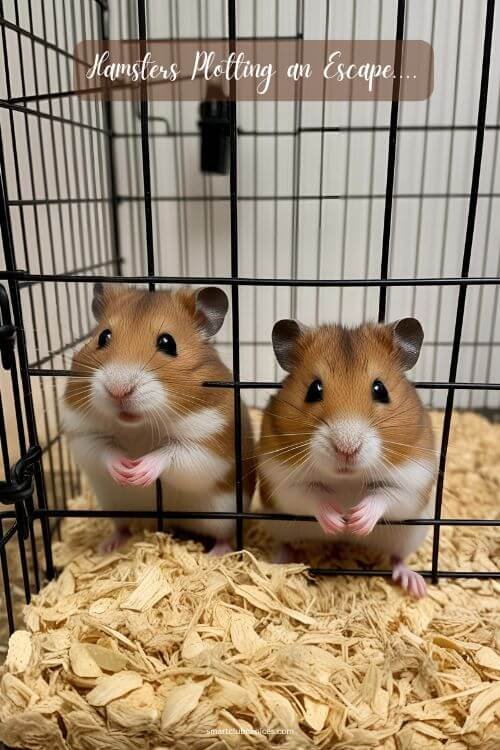How to Set Up the Perfect Hamster Cage
So, you’ve decided to bring a hamster into your life. Congratulations! These tiny, furry bundles of energy are about to become your new favorite roommates.
But before you introduce your hamster to their new home, there’s one crucial step: setting up the perfect hamster cage. Think of it as designing a luxury hamster resort—complete with cozy beds, fun activities, and plenty of snacks.
A well-designed cage isn’t just about keeping your hamster safe; it’s about creating a space where they can thrive, explore, and be their adorable selves. Let’s dive into the ultimate guide to setting up the perfect hamster cage!
Table of Contents
(1) Choosing the Right Cage – Size Matters
First things first: the cage. This is your hamster’s kingdom, so it needs to be spacious, secure, and comfortable. Here’s what to look for:
(i) Size
- Minimum Size: For Syrian hamsters, aim for a cage that’s at least 24×12 inches. For dwarf hamsters, 18×12 inches is the bare minimum.
- Bigger is Better: Hamsters love to explore, so if you can go bigger, do it! A larger cage means more room for toys, tunnels, and enrichment.
(ii) Type of Cage
- Wire Cages: These are great for ventilation and easy to clean. Just make sure the bar spacing is narrow enough to prevent escapes (especially for dwarf hamsters).
- Glass Tanks: Aquariums or terrariums work well for hamsters and provide excellent visibility. Make sure there’s a mesh lid for airflow.
- Plastic Habitats: These modular cages are fun and customizable but can be harder to clean.
(iii) Accessibility
- Choose a cage with wide doors or removable tops for easy cleaning and interaction.
Pro tip: Avoid cages with plastic tubes. They’re cute but can be hard to clean and don’t provide enough ventilation.

(2) Bedding and Nesting – The Cozy Foundation
Your hamster’s bedding is like their mattress, blanket, and pillow all in one. It needs to be soft, absorbent, and safe. Here’s how to get it right:
(i) Types of Bedding
- Paper-Based Bedding: Soft, absorbent, and dust-free. It’s a popular choice for most hamsters.
- Aspen Shavings: A safe wood-based option that’s great for burrowing.
- Avoid Cedar and Pine: These can release harmful chemicals and cause respiratory issues.
(ii) Depth
- Hamsters love to burrow, so provide at least 2-3 inches of bedding. For Syrian hamsters, go for 4-6 inches if possible.
(iii) Nesting Material
- Add unscented toilet paper or tissue for your hamster to shred and build their nest.
- Avoid cotton or fluffy bedding, as it can cause blockages if ingested.
Pro tip: Spot clean the bedding daily and do a full change once a week to keep the cage fresh and odor-free.
(3) Food and Water – Fuel for Your Furry Friend
A well-fed hamster is a happy hamster. Here’s how to set up their dining area:
(i) Food Bowl
- Choose a heavy, shallow dish to prevent tipping.
- Place it in a corner to keep it clean and accessible.
(ii) Hamster Food
- Provide a high-quality hamster mix that includes seeds, grains, and pellets.
- Supplement with fresh veggies like carrots, broccoli, and cucumber (in moderation).
- Avoid sugary or fatty treats, as hamsters are prone to obesity and diabetes.
(iii) Water Bottle
- Use a glass or BPA-free plastic water bottle with a metal spout.
- Check it daily to ensure it’s working and filled with fresh water.
Pro tip: Scatter some food around the cage to encourage foraging—it’s a fun and natural activity for your hamster.
(4) Toys and Enrichment – The Fun Zone
Hamsters are curious, active creatures that need mental and physical stimulation. Here’s how to turn their cage into a hamster playground:
(i) Exercise Wheel
- Choose a solid-surface wheel (no wire or mesh) to prevent injuries.
- For Syrian hamsters, aim for a wheel that’s at least 8-12 inches in diameter. For dwarf hamsters, 6-8 inches is ideal.
(ii) Tunnels and Hideouts
- Provide tunnels, tubes, and hideouts for your hamster to explore and nap in.
- You can use store-bought options or DIY with cardboard tubes and boxes.
(iii) Chew Toys
- Hamsters’ teeth never stop growing, so they need chew toys to keep them trimmed.
- Offer wooden chews, untreated apple sticks, or cardboard toys.
(iv) Climbing Opportunities
- Add platforms, ladders, or branches (make sure they’re safe and secure).
- Just be cautious with height—hamsters aren’t great climbers and can fall.
(v) Sand Bath
- Provide a small dish of chinchilla sand for your hamster to roll in. It helps keep their fur clean and shiny.
Pro tip: Rotate toys and rearrange the cage layout every few weeks to keep things interesting.
(5) Safety and Maintenance – Keeping It Clean and Secure
A safe and clean cage is essential for your hamster’s health and happiness. Here’s how to keep it in tip-top shape:
(i) Cage Placement
- Keep the cage in a quiet, draft-free area away from direct sunlight and loud noises.
- Avoid placing it near windows, radiators, or air vents.
(ii) Temperature
- Hamsters are sensitive to temperature changes. Aim for a consistent temperature between 65-75°F (18-24°C).
(iii) Cleaning Routine
- Daily: Spot clean soiled bedding and remove uneaten fresh food.
- Weekly: Do a full cage clean, replacing all bedding and washing accessories with mild soap and water.
(iv) Safety Checks
- Regularly inspect the cage for wear and tear, especially on wheels, toys, and water bottles.
- Make sure there are no sharp edges or small parts that could harm your hamster.
Pro tip: Use a pet-safe disinfectant for cleaning, and rinse thoroughly to avoid chemical residue.

(6) Conclusion: A Happy Hamster is a Well-Cared-For Hamster
Setting up the perfect hamster cage is like creating a tiny paradise for your furry friend. It’s not just about providing the basics—it’s about creating a space where your hamster can explore, play, and feel safe.
With the right cage, bedding, food, toys, and maintenance, you’ll have a happy, healthy hamster who’s ready to be your new best friend.
Remember, every hamster is unique, so don’t be afraid to experiment and adjust their environment to suit their personality and needs.
And most importantly, enjoy the process! Watching your hamster thrive in their new home is one of the most rewarding parts of being a pet parent.
Now, go forth and create the ultimate hamster haven. Your tiny, furry roommate is counting on you!








